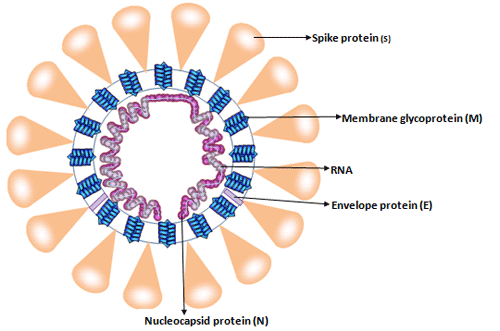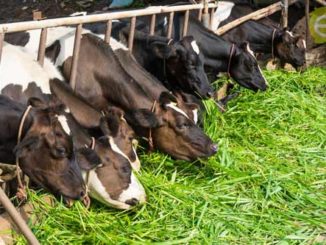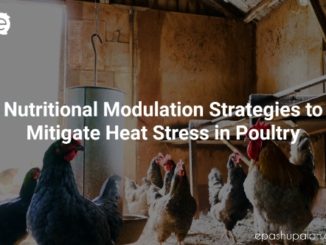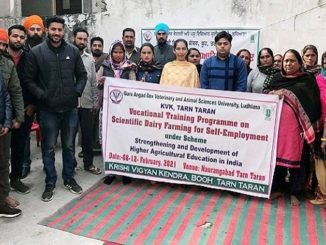Abstract
The people of India have now been habituated with announcement of new programme from Government of India at periodic intervals. Thus in past 6 years, we had witnessed Swacch Bharat Abhiyaan, Less Cess, Make in India etc. Now, there was something larger in the eyesight of Government and the global destruction and devastation of both human lives and economy in COVID-19 pandemic has provided the perfect platform for implementation of Atma Nirbhar Bharat Abhiyan stimulus package for ensuring growth in several sectors. Therefore, in his address to the nation on May 11, Prime Minister Narendra Modi called for an Atmanirbhar Bharat. The focus of the package aimed at making India self-reliant in the post-Covid-19 economic reconstruction by giving thrust on 2 themes – ‘vocal for local’ and ‘local to global’. As agriculture and animal husbandry sector emerged as the chief contributor of Indian GDP in recent past, therefore cabinet committee on economic affairs has approved setting up of Animal Husbandry Infrastructure Development Fund (AHIDF) worth INR 15000 crore. Since, almost 50-60 percent of final value of animal products in India flows back to farmers, therefore, growth in this sector can have significant direct impact on farmer’s income.
Introduction
2020 – A year of despair, distress, misery, pain for every individual. Entire macro world is under the grip of a microorganism SARS-COV-2 (Severe Acute Respiratory Syndrome – Corona Virus 2) or COVID – 19(Corona Virus Disease – 2019) which is only 30Kb in size. 2020 has been chiefly defined as the COVID-19 pandemic which shook the entire world with its severe impact on health of millions and global economic recession. The virus was first discovered in Wuhan, a city of financial capital of Hubei province located in Central China on 30th December 2019 (Gao 2020; Lu et al. 2020). The World Health Organization declared this highly transmittable and pathogenic viral infection a Public Health Emergency of International Concern on 30 January 2020 and a pandemic on 11 March (Chatterjee et al. 2020; Zheng 2020). As of 1st November 2020, more than 46 million cases and approximately 12 lakh deaths have been reported globally in more than 188 countries and territories. Since then, this pandemic has evolved into global public health and economic crisis that has affected the $90 trillion global economy beyond anything experienced in recent past (WHO, 2020)
India has not escaped from the wrath of COVID-19 and breached 82 lakhs confirmed cases so far, making it second most affected country in the world. India’s case fatality rate is among the lowest in the world with 1.49% as of 1st November and is constantly declining. India’s recovery rate currently stands at 91.51% and is steadily improving (COVID-19.India). These facts and figures have been attributed to proper implementation of necessary precautionary measures. However, India has not escaped from the danger position created by this pandemic situation. The Central and respective state government has undertaken several steps to restrain the occurrence of new confirmed cases keeping in view the Indian life and livelihood. This article will describe the various insights of Indian Government for betterment of health, economy and lifestyle.
Brief Description of Coronaviruses

Before going deep into the havoc caused by this deadly virus, we should have some knowledge regarding this highly transmittable and pathogenic virus. Corona name represents crown-like spikes on the outer surface of virus belong to Coronaviridae family of Nidovirales order (Wu et al., 2016). Coronaviruses are small sized (65-125 nm in diameter) and contain a single stranded RNA as nuclear material with 26 – 32 Kb in length. Coronaviruses are divided into 4 subgroups namely alpha (α), beta (β), gamma (γ) and delta (δ) (Harapan et al., 2020). The Severe Acute Respiratory Syndrome coronaviruses (SARS), Middle East Respiratory Syndrome (MERS-CoV) and recently added 2019 novel coronavirus (2019-ncov) which cause Acute Respiratory Distress Syndrome (ARDS) that leads to pulmonary failure and fatality. Previously these viruses were thought to infect animals only until the world witnessed a Severe Acute Respiratory Syndrome (SARS) caused by SARS-CoV, 2002 in Guangdong, China thereby infecting 8098 individuals and 776 deceased cases with a mortality rate of 9% around the globe. Only a decade later in 2012, few Saudi Arabian nationals and individuals in Arabian Peninsula witnessed a mild respiratory disease similar to SARS coronavirus ultimately leading to pneumonia, ARDS and renal failure which was diagnosed as Middle East Respiratory Syndrome (MERS) caused by β subgroup of coronaviruses. WHO reported around 2500 confirmed cases alongwith 35% case fatality rate (Huang et al., 2020).
Animals are believed to be the source of origin for different coronavirus outbreaks. As coronavirus possess the highest zoonotic and pandemic potential among all microorganisms, entire human race needs to be careful regarding judicious utilisation of various animal products. During SARS-CoV outbreak in 2002, researchers initially concentrated on raccoon dogs and palm civets as key reservoir of infection but later on RNA analysis showed palm civets as secondary host (Shi and Hu, 2008; Hu et al., 2015). In 2012, emergence of MERS coronavirus in Saudi Arabia pertains to dromedary camels as zoonotic or primary host but recent studies also correlates Pipistrellus and Perimyotis bats as the transmitting medium of the virus (van Boheeman et al., 2012; Haggmans et al., 2014). Early circumstantial evidence of COVID-19 linked the Huanan seafood market that sells exotic live animals but genetic analysis showed 88 – 89% identical to two bat origin SARS coronaviruses (bat-SL-CoVZC45 and bat-SL CoVZXC21, also named as ZC45 and ZXC21), while it is 82% identical to human SARS-CoV Tor2 (Zhou et al., 2020).
Effects on Indian Economy
Till date, COVID-19 pandemic has turned into a grave menace to the entire nation not only by affecting millions of health but also showed negative repercussions on global business world agitating the entire economic system, trade and commerce. Keeping in view the outburst of cases, Indian government took necessary actions by announcing complete lockdown and shutdown in every corner of country since 23rd March 2020. Metropolitan cities like Delhi, Mumbai, Kolkata, Ahmadabad, Bengaluru, and Chennai served as the engines of growth and development of Indian economy. Amidst lockdown, everything including normal life and livelihood seems to be grinding to a halt. Therefore, Indian Government specifically planned certain strategies for Indian economy to cope up with the effects of pandemic and survive in this tough situation (Rakshit and Paul, 2020).
Impact of Animal Husbandry on Indian Economy
Indian livestock sector has played an indispensible role in shaping the structure of Indian economy. Indian economy is widely regarded as “agrarian economy” and farmers serve as the backbone of it. Indian livestock sector is one of the largest in global scenario with 11.6% holdings of world thereby serving as pillar of strength by bringing an additional source of steady income (Shanmathy et al., 2018). But COVID-19 pandemic has shackled the growth and development of animal husbandry sector thereby affecting the livelihood of millions of farmers. Therefore, to rebuild the economy Prime Minister Narendra Modi in his address to the nation on May 12th called for an “Atmanirbhar Bharat” in every field laying an emphasis on “Vocal for Local” to achieve the goal of “Local to Global”. Therefore, under this “Atmanirbhar Bharat Abhiyan” our honourable Prime Minister emphasised on restructuring and revitalizing the present institutional set-up in the livestock sector in order to enhance institution-level efficiency, and promote new institutional models to handle the emerging challenges in livestock sector development. The efforts should aim to promote and nurture the grass-root level participatory bodies all over the country as the organic link between the animal husbandry department and the smallholders.
India imports significant volumes of electronic products, crude and edible oils, minerals etc to meet the domestic demand. With respect to these imports, one of the best examples of ‘Atmanirbharta’ is associated with animal husbandry sector especially dairying, where self-sufficiency in milk production was achieved decades ago. At present, India’s milk production is double than that of the USA and 25% more than Europe’s. In line with Atma Nirbhar Bharat Abhiyan package, the Cabinet Committee on Economic Affairs had allotted whopping Rs15,000cr for setting up of Animal Husbandry Infrastructure Development Fund (AHIDF) in order to boost up Farmer Producer Organizations (FPOs), MSMEs, Section 8 Companies, Private Companies and individual entrepreneur which includes private investment in Dairy Processing, value addition and cattle feed infrastructure. Apart from that, government launched National Animal Disease Control Programme for Foot and Mouth Disease (FMD) and Brucellosis with total outlay of Rs. 13,343 crore to ensure 100% vaccination of cattle, buffalo, sheep, goat and pig population (total 53 crore animals) for Foot and Mouth Disease (FMD) and for brucellosis with an aim to control the livestock diseases by 2025 and eradicate by 2030. Till date, 1.5 crore cows & buffaloes were tagged and vaccinated.
India has a vast livestock resources and share of livestock sector to GDP (6%) and Agricultural GDP (25%) has been increasing faster than the agriculture sector due to rising demand for livestock products, food and food articles, raw materials, finished products (Dash, 2017). Being the highest livestock owner of the world, animal rearing has been emphasised since time immemorial because of its multidimensional potential. Therefore, it has a big potential for providing non-farm employment and income in rural areas. For instance, Operation Flood, launched in 1970, helped dairy farmers direct their own development, increased milk production (“a flood of milk”), augmented rural incomes and ensuring reasonable prices for consumers (Shanmathy et al., 2018). This production system assumes special significance in economic growth, increasing income and increasing urbanization, changes in taste and preference that have led to nutritional changes reflecting the importance of milk, meat, egg and fish in the daily diets of the people. The animal production system in India is principally part of a mixed crop-livestock farming system and important for the security and survival of large number of poor populace. It acts as a major risk mitigation approach for small and marginal farmers by providing food and nutritional security thereby acting as a cushion against crop failure, particularly across the rain-fed regions of India. Apart from uplifting the social and economic status of small and marginal farmers, integrated and mixed farming helps in improving the biological quality of soil, feeds etc. The recycling of animal dung or wastes in fish pond is important for sustainable aquaculture. When sheep and goat are allowed to graze freely on crop residue, their droppings and urine proved to be fertiliser for next crop. Diverse enterprises of livestock like Apiculture, Sericulture, Pisciculture, backyard poultry production has not only provided self-employment to millions of rural households but also contributed significantly to the empowerment of women in society. Apart from providing regular source of income, animals like sheep and goat serve as emergency source of income to meet exigencies like marriages; treatment of sick persons, children education, repair of houses etc. thereby qualified enough to be considered as “moving banks”(Dash, 2017). Being classified as geographically and climatically diversified country, rearing of wide variety of animals like mithun, yak, camel, pig apart from cattle, sheep and goat are unique characteristics of animal husbandry in India. Swine rearing is common in certain parts of country and its market value improves the economy into manifold. In high altitude regions, yaks and mithun provide milk, meat, fur and transport. Rabbit farming is a profitable venture in present date as it needs less space and reared in cages like poultry. They are the best producers of wool on per Kilogram body weight basis and require 30 percent less digestible energy to produce 1 kg of wool as compared to sheep. Poultry occupies a special place in Indian diet as chicken is widely accepted meat in India and egg acts the supplementary part of every vegetarian diet. Therefore, Poultry is one of the fastest growing segments of the agricultural sector making India world’s fifth largest egg producer and the eighteenth largest producer of broilers (Basic Animal Husbandry Statistics, 2019). Indian honey has gained a good export potential with the use of modern collection, storage, bee keeping equipment and honey processing plants. India exports 50 per cent of the commodity and, in the last 12 years, exports have increased by 207 per cent. Animal husbandry sector not only improves the livelihood of farmers but also helps a lot in production of clean energy. Being the largest livestock storehouse of the world, dung cakes not only reduces the expenditure on fuel for cooking in rural India, but also biogas technology provides excellent opportunity for mitigation of greenhouse gases emissions and global warming.
Conclusion
Currently, entire world is under the clutch of a dreadful virus which has not only sparked a global health emergency but also left its significant impact on global economy. In respond to present scenario, Indian policymakers should acknowledge, accept and apprehend the livestock sector in terms of production, value addition, and export of dairy, fishery, wool, poultry, and other products which they have been noticing for a decade now. As animal husbandry sector controls a major part of agricultural gross domestic product and acts as a vital cog in Indian economy, we need to overcome the threats to grab the global market opportunities.
Reference
- Basic Animal Husbandry Statistics – 2019. https://dahd.nic.in/circulars/basic-animal-husbandry-statistics-2019
- Chatterjee, P., Nagi, N., Agarwal, A., Das, B., Banerjee, S., Sarkar, S., Gupta, N. and Gangakhedkar, R.R., 2020. The 2019 novel coronavirus disease (COVID-19) pandemic: A review of the current evidence. Indian Journal of Medical Research, 151(2), p.147.
- COVID-19.India//https://www.covid19india.org/
- Dash, S., 2017. Contribution of Livestock Sector to Indian Economy. Paripex-Indian Journal of Research, 6(1), pp.890-891.
- Gao, Z.C., 2020. Efficient management of novel coronavirus pneumonia by efficient prevention and control in scientific manner. Zhonghua jie he he hu xi za zhi= Zhonghua jiehe he huxi zazhi= Chinese journal of tuberculosis and respiratory diseases, 43, pp.E001-E001.
- Haagmans, B.L., Al Dhahiry, S.H., Reusken, C.B., Raj, V.S., Galiano, M., Myers, R., Godeke, G.J., Jonges, M., Farag, E., Diab, A. and Ghobashy, H., 2014. Middle East respiratory syndrome coronavirus in dromedary camels: an outbreak investigation. Lancet Infect. Dis. 14:140–145. http://dx.doi.org/10.1016/S1473-3099(13)70690-X.
- Harapan, H., Itoh, N., Yufika, A., Winardi, W., Keam, S., Te, H., Megawati, D., Hayati, Z., Wagner, A.L. and Mudatsir, M., 2020. Coronavirus disease 2019 (COVID-19): A literature review. Journal of Infection and Public Health.
- Hu, B., Ge, X., Wang, L.F. and Shi, Z., 2015. Bat origin of human coronaviruses. Virology journal, 12(1), pp.1-10.
- Huang, C., Wang, Y., Li, X., Ren, L., Zhao, J., Hu, Y., Zhang, L., Fan, G., Xu, J., Gu, X. and Cheng, Z., 2020. Clinical features of patients infected with 2019 novel coronavirus in Wuhan, China. The lancet, 395(10223), pp.497-506.
- Lu, H., Stratton, C.W. and Tang, Y.W., 2020. Outbreak of pneumonia of unknown etiology in Wuhan, China: The mystery and the miracle. Journal of medical virology, 92(4), pp.401-402.
- Rakshit, D. and Paul A., 2020. Impact of Covid-19 on Sectors of Indian Economy and Business Survival Strategies. International Journal of Engineering and Management Research, 10(3), pp. 51 – 55.
- Shanmathy, M., Gopi, M. and Beulah, P., 2018. Contribution of animal husbandry to Indian economy, its characteristics and future: A Review. Asian Journal of Agricultural Extension, Economics & Sociology, 27(1), pp.1-7.
- Shi, Z. and Hu, Z., 2008. A review of studies on animal reservoirs of the SARS coronavirus. Virus research, 133(1), pp.74-87.
- van Boheemen, S., de Graaf, M., Lauber, C., Bestebroer, T.M., Raj, V.S., Zaki, A.M., Osterhaus, A.D., Haagmans, B.L., Gorbalenya, A.E., Snijder, E.J. and Fouchier, R.A., 2012. Genomic characterization of a newly discovered coronavirus associated with acute respiratory distress syndrome in humans. MBio, 3(6).
- 2020. Coronavirus disease 2019 (COVID-19) Situation Report – 103. https://www.who.int/docs/default-source/coronaviruse/situationreports/20200502-covid-19-sitrep-103.pdf?sfvrsn=d95e76d8_4.
- Wu, Z., Yang, L., Ren, X., Zhang, J., Yang, F., Zhang, S. and Jin, Q., 2016. ORF8-related genetic evidence for Chinese horseshoe bats as the source of human severe acute respiratory syndrome coronavirus. The Journal of infectious diseases, 213(4), pp.579-583.
- Zheng, J., 2020. SARS-CoV-2: an emerging coronavirus that causes a global threat. International journal of biological sciences, 16(10), p.1678.
- Zhou, F., Yu, T., Du, R., Fan, G., Liu, Y., Liu, Z., Xiang, J., Wang, Y., Song, B., Gu, X. and Guan, L., 2020. Clinical course and risk factors for mortality of adult inpatients with COVID-19 in Wuhan, China: a retrospective cohort study. The lancet, 395 (10229), pp. 1054−







1 Trackback / Pingback